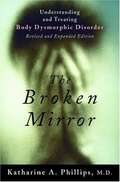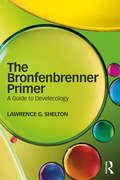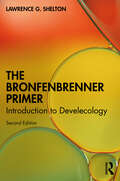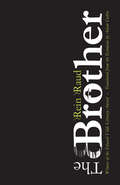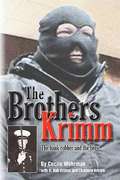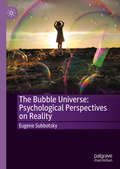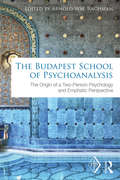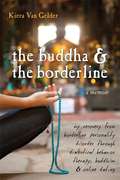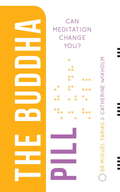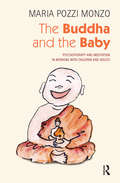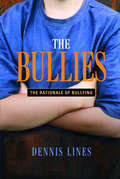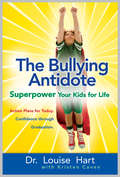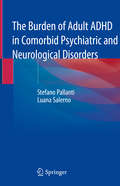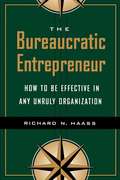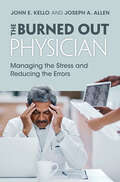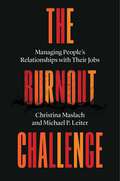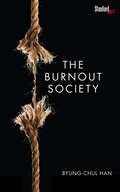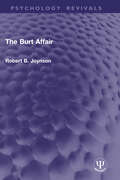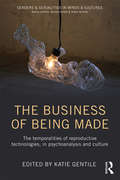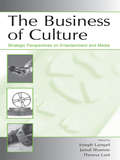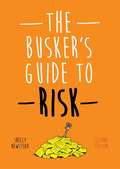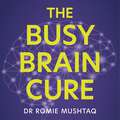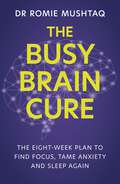- Table View
- List View
The Broken Mirror: Understanding and Treating Body Dysmorphic Disorder
by Katharine Phillips<p>In a world obsessed with appearances, it is not surprising that body dysmorphic disorder, or BDD, has manifested itself as a troubling and relatively common problem for many individuals. In The Broken Mirror, the first and most definitive book on BDD, Dr. Katharine Phillips draws on years of clinical practice, scientific research, and professional evaluations of over 700 patients to bring readers her expertise and experience with this often debilitating illness. BDD causes sufferers to be obsessed by perceived flaws in their appearance and may afflict as much as two percent of the population, or nearly five million people. Many sufferers are able to function well in society, but remain secretly obsessed by their "hideous acne" or "horrible nose," sneaking constant peeks at a pocket mirror, or spending hours at a time redoing makeup. Others find their lives disintegrate because of their appearance obsessions. It is not an uncommon disorder, simply a hidden one, since sufferers are often embarrassed to tell even their closest friends about their concerns. <p>The author presents the stories and interviews of over 200 individuals to show the many different behaviors and symptoms of BDD, and includes a quick self-assessment questionnaire. Four new chapters provide updated information on treatment of BDD, frequently obtained treatments to be avoided, and more detailed advice for family members and friends on how to cope with the disorder. <p>Left untreated, the torment of BDD can lead to psychiatric hospitalization and sometimes suicide. With treatment, many sufferers are able to lead normal lives. The Broken Mirror is literally a lifesaving handbook for sufferers, their families, and their doctors.</p>
The Bronfenbrenner Primer: A Guide to Develecology
by Lawrence SheltonThis is the first ever introduction to Urie Bronfenbrenner’s Ecological Systems Framework written specifically for undergraduate students. The author provides a carefully structured, guided introduction to Bronfenbrenner’s concepts, their interpretation, and their potential applications. Bronfenbrenner’s scientific analysis of the role the environment plays in human development earned him a premier place alongside Jean Piaget, Sigmund Freud, and Erik Erikson as a contributor to our understanding of developmental processes. His ideas are essential for analysing how development happens, how it goes astray, how to right it when it does, and how to create environments that will promote healthy development. The Bronfenbrenner Primer walks students through each component of the framework in a logical order, helping students build a solid, systematic understanding. It describes the background and context that led Bronfenbrenner to develop his framework, illustrates a wide array of potential applications, and provides activities students can do to practice applying the framework to their own experience. Honed over 25 years of teaching Bronfenbrenner’s ideas, this text will be essential reading for students across the behavioral and social sciences.
The Bronfenbrenner Primer: Introduction to Develecology
by Lawrence G. SheltonThis revised and updated second edition of The Bronfenbrenner Primer builds on one of the first-ever introductions to acclaimed child psychologist Urie Bronfenbrenner’s Ecological Systems Model of Development Framework, written specifically for undergraduate students. The author provides a carefully structured, guided introduction to Bronfenbrenner’s concepts, their interpretation, and their potential applications.Bronfenbrenner’s scientific analysis of the role the environment plays in human development is essential for understanding how and why development happens, how our environments can promote healthy development, and how to address developmental issues when they arise. Shelton emphasizes building a systematic foundation for using the theory to understand real situations and apply it practically. The book describes the background and context that led Bronfenbrenner to develop his framework, illustrates a wide array of potential applications, and provides activities for students to practice applying the framework to their own experiences. This new edition includes expanded coverage on adolescents and adults, incorporating up-to-date examples relevant to life post-pandemic. It also addresses diverse perspectives and living environments and provides several applications and exercises to help explain Bronfenbrenner’s concepts.The Bronfenbrenner Primer is a highly regarded and valuable resource for students beginning their studies in Developmental Psychology, Family Science, Sociology, Health Sciences, Social Work, Education, and for anyone interested in understanding the social world.
The Brother
by Rein Raud Adam CullenThe Brother is a spaghetti western told in poetic prose, simultaneously paying tribute to both Clint Eastwood and Alessandro Baricco. It opens with a mysterious stranger arriving in a small town controlled by a group of men-men who recently cheated the stranger's supposed sister out of her inheritance. Following his arrival, fortunes change dramatically, enraging this group of powerful men.
The Brothers Krimm: The Bank Robber and the Hero
by Cecile Wehrman H. Krimm Charlene KrimmOn September 14, 2009, a serial bank bandit scores one of his biggest hauls ever in Williston, N. D. Jimmy Krimm has been robbing banks for most of his adult life, but the biggest crime he ever committed took place before he left his mother's Michigan home decades earlier. When police deliver the news that her oldest son is dead, Charlene Krimm is left pining for any children he may have fathered, and with the task of breaking the news to her younger son, Rob -- Jimmy's first victim. "The Brothers Krimm" examines the way childhood sexual abuse forms two men --turning one into a predator -- and the other into the kind of hero whose triumph is found in his will to rise above the past. In the wake of the events of September 14, 2009, a small town reporter is compelled to dig deeper into the mystery of Jimmy Krimm. Driven by the desire to help his family gain closure, Cecile Wehrman sets out to follow the trail of a serial bank robber -- a trail that leads, inexplicably, to her own doorstep - to the abuse in her own past, and to the very real possibility she could have been Jimmy's next victim. From Chapter 1: "It's a story that will test all of my skills as a researcher. I will have to examine my ethics as a journalist. I will have to open old wounds, personal wounds. My faith will be shaken. Inconsequential things, something as simple as finding a penny, will take on new meaning. . . And it won't be until many months into it that my research will uncover an inexplicable connection to this robber -- this man who terrorized my neighborhood. It is a piece of evidence so startling it will literally knock me to the ground. "With the cooperation of the Krimm family, through prison documents, police records and even Jimmy's own words and photos from the road during his final bank robbing spree, Wehrman chronicles the exploits of a modern day Jesse James - dispelling forever the notion of the dashing bank bandit and replacing it with the portrait of a homeless wanderer who took what he needed, no matter who it hurt.
The Bubble Universe: Psychological Perspectives on Reality
by Eugene SubbotskyThis book examines the role that human subjective experience plays in the creation of reality and introduces a new concept, the Bubble Universe, to describe the universe as it looks from the subjective viewpoint of an individual. Drawing on a range of research, the author questions the extent to which the scientific study of the origins of life, consciousness and subjective experience is itself influenced by scientists’ subjective worlds.The author argues that in many respects the Bubble Universe differs from the universe as described by science and religion, and analyzes these differences. The fabric and structure of subjective reality is described, and various aspects of the Bubble Universe are examined, including science, religion, life, morality and history. The differences between the views from inside the subjective universe and from scientific, religious and sociocultural versions of the universe are outlined, and their significance for practical and theoretical problems are highlighted and illustrated with psychological experiments. This book will be of value to all scholars interested in how subjectivity influences research and appeal in particular to those working in developmental and theoretical psychology, consciousness, epistemology, phenomenology, and the philosophy of science and of the mind.
The Budapest School of Psychoanalysis: The Origin of a Two-Person Psychology and Emphatic Perspective (Psychoanalytic Inquiry Book Series)
by Arnold RachmanThe Budapest School of Psychoanalysis brings together a collection of expertly written pieces on the influence of the Budapest (Ferenczi) conception of analytic theory and practice on the evolution of psychoanalysis. It touches on major figures Sándor Ferenczi and Michael Balint whilst concurrently considering topics such as Ferenczi’s clinical diary, the study of trauma, the Confusion of Tongues paradigm, and Balint’s perspective on supervision. Further to this, the book highlights Jacques Lacan’s teaching of Ferenczi, which brings a fresh perspective to a relatively unknown connection between them. The book highlights that the Hungarian analysts, influenced by Ferenczi, through their pioneering work developed a psychoanalytic paradigm which became an alternative to the Freudian tradition. That this paradigm has become recognised and admired in its own right underlines the need to clearly outline, as this book does, the historical context and the output of those who are writing and working in the tradition of the Budapest School. The contributions to this volume demonstrate the widespread and enduring influence of the Budapest School on contemporary psychoanalysis. The contributors are amongst the foremost in Budapest School scholarship and the insights they offer are at once profound as well as insightful. This book is an important read for those practitioners and students of psychoanalysis who wish for an insight into the early and developing years of the Budapest School of Psychoanalysis and its impact on contemporary clinical practice.
The Buddha And The Borderline: A Memoir - My Recovery From Borderline Personality Disorder Through Dialectical Behavior Therapy, Buddhism, And Online Dating
by Kiera Van GelderKiera Van Gelder's first suicide attempt at the age of twelve marked the onset of her struggles with drug addiction, depression, post-traumatic stress, self-harm, and chaotic romantic relationships-all of which eventually led to doctors' belated diagnosis of borderline personality disorder twenty years later. The Buddha and the Borderline is a window into this mysterious and debilitating condition, an unblinking portrayal of one woman's fight against the emotional devastation of borderline personality disorder. This haunting, intimate memoir chronicles both the devastating period that led to Kiera's eventual diagnosis and her inspirational recovery through therapy, Buddhist spirituality, and a few online dates gone wrong. Kiera's story sheds light on the private struggle to transform suffering into compassion for herself and others, and is essential reading for all seeking to understand what it truly means to recover and reclaim the desire to live.
The Buddha Pill
by Miguel Farias Catherine WikholmMillions of people meditate daily but can meditative practices really make us 'better' people? In The Buddha Pill, pioneering psychologists Dr Miguel Farias and Catherine Wikholm put meditation and mindfulness under the microscope. Separating fact from fiction, they reveal what scientific research - including their groundbreaking study on yoga and meditation with prisoners - tells us about the benefits and limitations of these techniques for improving our lives. As well as illuminating the potential, the authors argue that these practices may have unexpected consequences, and that peace and happiness may not always be the end result. Offering a compelling examination of research on transcendental meditation to recent brain-imaging studies on the effects of mindfulness and yoga, and with fascinating contributions from spiritual teachers and therapists, Farias and Wikholm weave together a unique story about the science and the delusions of personal change.
The Buddha Pill: Can Meditation Change You?
by Miguel Farias Dr Catherine WikholmMillions of people meditate daily but can meditative practices really make us ‘better’ people? In The Buddha Pill, pioneering psychologists Dr Miguel Farias and Catherine Wikholm put meditation and mindfulness under the microscope. Separating fact from fiction, they reveal what scientific research – including their groundbreaking study on yoga and meditation with prisoners – tells us about the benefits and limitations of these techniques for improving our lives. As well as illuminating the potential, the authors argue that these practices may have unexpected consequences, and that peace and happiness may not always be the end result. Offering a compelling examination of research on transcendental meditation to recent brain-imaging studies on the effects of mindfulness and yoga, and with fascinating contributions from spiritual teachers and therapists, Farias and Wikholm weave together a unique story about the science and the delusions of personal change.
The Buddha and the Baby: Psychotherapy and Meditation in Working with Children and Adults
by Maria Pozzi MonzoThese dialogues with child, adolescent and adult psychotherapists and child psychiatrists focus on their personal as well as professional experiences. All the contributors have a long-standing practice of Buddhism or other forms of meditation. The relevance of this to their clinical work with infants, children, adolescents, families and adults is described. Buddhist principles such as suffering, impermanence, non-attachment, no-self and the Four Noble Truths influence the contributors' practice of psychotherapy with children and with the child in the adult. Similarities and differences between the two traditions of Buddhism and psychotherapy are highlighted in these dialogues, which are embedded in deep, personal and transforming experiences that are shared by the authors.
The Bullies: Understanding Bullies and Bullying
by Dennis Lines'Dennis Lines shares his deep understanding and illustrates from long practical experience in the field of counselling, bullying and aggression.' - Educational Review Canterbury Christ Church University, UK Carl Parsons Is there a particular type of person who becomes a bully? Why do bullies behave like they do? How can we interpret and understand bullying within relationships? The Bullies attempts to get inside the minds of the bully and victim - the child, the adolescent and the adult - across a wide range of 'closed' situations including the home, school and workplace, prisons and the armed services. By listening to the voices of bullies and victims from all kinds of backgrounds without making judgements, counsellor Dennis Lines provides unique insights into bullying and what makes such domineering and aggressive behaviour so complex. He discusses controversial issues such as genetic predisposition towards abusive behaviour and draws on his counselling knowledge to provide insights on how to understand and treat bullies to change their behaviour. The Bullies offers a unique and illustrated perspective on a widespread phenomenon, and will be essential reading for psychologists, sociologists, counsellors, teachers, social workers, probation officers, students and researchers.
The Bullying Antidote
by Kristen Caven Louise HartThis big-picture look at bullying by community psychologist Dr. Louise Hart and her co-author, Kristen Caven (other books include The Winning Family and On the Wings of Self-Esteem), takes on the challenge of correcting the common and widespread parenting practices that contribute to today's bullying epidemic.Drawing from psychological, medical, sociological, educational, and neurological research, they build a theory of bullying that spans across communities and generations, one that will ring a bell for most parents. The book teaches hundreds of specific, positive practices to turn the next generation of children into richly developed, healthy adolescents and adults who possess what the authors lightly label "ZORGOS," the superpower that defeats bullying. The overall intent is not just to stop a single bullying incident, but to develop immunity in today's children to future bullying events. The Bullying Antidote shows how parents and community leaders, by becoming educated about the mechanics of power dynamics and prevention, can build bully-free, emotionally safe families, neighborhoods, and communities.Some of the things parents will learn in this book:1. Parenting styles that can either nurture or interrupt bullying behaviors2. Three ways parents with good intentions unknowingly raise bullies3. What bullying is and what it is not4. What to do when your child is bullied, bullies, or witnesses bullying5. How to build a child's core strengths and competencies6. How assertive communication is non-violent communication7. How nurture and structure balance family life and emotions8. How to build your authority without being a dictator9. Ten ways to build resilience10. How to use technology positively at all agesThe authors provide an online resource for readers of this book. Search zorgos.wordpress for links, notes, a discussion guide and an author interview.
The Burden of Adult ADHD in Comorbid Psychiatric and Neurological Disorders
by Stefano Pallanti Luana SalernoThis book highlights the importance of investigating for ADHD in adults with attention difficulties, poor memory and executive function impairments. The authors advocate a neurodevelopmental assessment approach in all phases of life, and explain how to perform such assessments. The identification of ADHD in adults with other psychiatric and neurological disorders will lead to a better response to treatments, and as a result reduce its social, economic and personal burden. ADHD can no longer be considered solely a pediatric condition, as it occurs in a significant proportion of adults worldwide. However, ADHD in adults is often unrecognized and untreated. Diagnosing the disorder in adulthood is a challenge, due not only to the different clinical presentation in this phase of life, but also to the fact that other conditions may mask the symptoms. ADHD constitutes a hidden comorbidity with a detrimental impact of those affected, and a poor response (or even non-response) to several treatments. Intended for psychiatrists, neurologists, specialists in gerontology and neuropsychology, this book is an indispensable resource for all mental health practitioners who want to optimize the treatment of patients affected by psychiatric and neurological disorders who respond poorly to standard treatments.
The Burdens of Proof
by Dale A. NanceAdjudicative tribunals in both criminal and non-criminal cases rely on the concept of the 'burden of proof' to resolve uncertainty about facts. Perhaps surprisingly, this concept remains clouded and deeply controversial. Written by an internationally renowned scholar, this book explores contemporary thinking on the evidential requirements that are critical for all practical decision-making, including adjudication. Although the idea that evidence must favor one side over the other to a specified degree, such as 'beyond reasonable doubt', is familiar, less well-understood is an idea associated with the work of John Maynard Keynes, namely that there are requirements on the total amount of evidence considered to decide the case. The author expertly explores this distinct Keynesian concept and its implications. Hypothetical examples and litigated cases are included to assist understanding of the ideas developed. Implications include an expanded conception of the burden of producing evidence and how it should be administered.
The Bureaucratic Entrepreneur: How to Be Effective in Any Unruly Organization
by Richard N. HaassHaass (vice president and director, Foreign Policy Studies program at the Brookings Institution) provides guidelines on how to manage relationships, set goals, and translate them into success. His insights into delicate working relationships will benefit those in government, the corporate world, and the non-profit sector, as well as students of public administration and business. This is a revised edition of Houghton Mifflin, 1994. This edition includes anecdotes from the Clinton administration. Annotation c. Book News, Inc., Portland, OR (booknews.com)
The Burned Out Physician: Managing the Stress and Reducing the Errors
by Joseph A. Allen John E. KelloBurnout is a major psychological and physical health-related problem for workers in all fields, but especially for those in the fast-paced and rapidly changing world of healthcare. Burnout has severe consequences for patients, including medical error, and is a leading contributing cause of depression and suicide among healthcare workers. Organizational science is just beginning to be applied in earnest to physician burnout and patient safety, and holds several potential keys to addressing these concerns. The Burned Out Physician is for two groups: healthcare workers (especially physicians) and patients. Physicians will use this book to get an accurate picture of what they are experiencing and how to change it, and patients will use this book to see what their healthcare providers are experiencing and learn how to help and/or protect themselves. The volume includes a checklist of burnout symptoms, and crucially a list of solutions as part of an active effort to solve the burnout crisis.
The Burnout Challenge: Managing People’s Relationships with Their Jobs
by Michael P. Leiter Christina MaslachTwo pioneering researchers identify key causes of workplace burnout and reveal what managers can do to promote increased productivity and health.Burnout is among the most significant on-the-job hazards facing workers today. It is also among the most misunderstood. In particular, we tend to characterize burnout as a personal issue—a problem employees should fix themselves by getting therapy, practicing relaxation techniques, or changing jobs. Christina Maslach and Michael P. Leiter show why this is not the case. Burnout also needs to be managed by the workplace.Citing a wealth of research data and drawing on illustrative anecdotes, The Burnout Challenge shows how organizations can change to promote sustainable productivity. Maslach and Leiter provide useful tools for identifying the signs of employee burnout, most often exhaustion, cynicism, and ineffectiveness. They also advise managers on assembling and interpreting worker self-evaluation surveys, which can reveal workplace problems and potential solutions. And when it comes to implementing change, Maslach and Leiter offer practical, evidence-driven guidance. The key, they argue, is to begin with less-taxing changes that employees nonetheless find meaningful, seeding the ground for more thorough reforms in the future.Experts estimate that more than $500 billion and 550 million workhours are lost annually to on-the-job stress, much of it caused by dysfunctional work environments. As priorities and policies shift across workplaces, The Burnout Challenge provides pragmatic, creative, and cost-effective solutions to improve employee efficiency, health, and happiness.
The Burnout Society
by translated by Erik Butler Byung-Chul HanOur competitive, service-oriented societies are taking a toll on the late-modern individual. Rather than improving life, multitasking, "user-friendly" technology, and the culture of convenience are producing disorders that range from depression to attention deficit disorder to borderline personality disorder. Byung-Chul Han interprets the spreading malaise as an inability to manage negative experiences in an age characterized by excessive positivity and the universal availability of people and goods. Stress and exhaustion are not just personal experiences, but social and historical phenomena as well. Denouncing a world in which every against-the-grain response can lead to further disempowerment, he draws on literature, philosophy, and the social and natural sciences to explore the stakes of sacrificing intermittent intellectual reflection for constant neural connection.
The Burt Affair (Psychology Revivals)
by Robert B. JoynsonFew reputations had undergone so dramatic a reversal as that of the late Sir Cyril Burt. When he died in 1971, he was widely acclaimed as a founding father of British psychology and a commanding figure in the world of education. His decline began when it was alleged, some five years later, that he had fraudulently invented much of his most influential data on the inheritance of intelligence. The dispute which followed is one of the great causes célèbres of psychology.Originally published in 1989, Robert B. Joynson took a penetrating new look at the ‘Burt Affair’, examining in detail the grounds on which Burt had been accused. He concluded that the accusations were ill-founded and that Burt must be exonerated.Dr Joynson’s conclusions raised wider issues for psychology itself. How did such accusations come to be made, and how did they come to be so widely accepted? Joynson believed that the episode pointed to inherent weaknesses and limitations in the discipline of psychology itself.
The Business of Being Made: The temporalities of reproductive technologies, in psychoanalysis and culture (Genders & Sexualities in Minds & Cultures)
by Katie GentileThe Business of Being Made is the first book to critically analyze assisted reproductive technologies (ARTs) from a transdisciplinary perspective integrating psychoanalytic and cultural theories. It is a ground-breaking collection exploring ARTs through diverse methods including interview research, clinical case studies, psychoanalytic based ethnography, and memoir. Gathering clinicians and researchers who specialize in this area, this book engages current research in psychoanalysis, sociology, anthropology, philosophy and debates in feminist, queer and cultural theory about affect, temporality, and bodies. With psychoanalysis as its fulcrum, The Business of Being Made explores the social constructions and personal experiences of ARTs. Katie Gentile frames the cultural context, exploring the ways ARTs have become a complex form of playing with time, attempting to manufacture a hopeful future in the midst of growing global uncertainty. The contributors then present a range of varied experiences related to ARTs, including: Interviews with women and men undergoing ARTs; A psychoanalytic memoir of male infertility; Clinical research and work with transgender, gay and lesbian patients creating new Oedipal constellations, the experiences of LBGTQ people within the medical system and the variety of families that emerge; Research on the experiences of egg donors (now central to the business of ARTs) and a corresponding clinical case study of successful egg donation; The experiences of ongoing failure which is the often unacknowledged for ART procedures; How and when people choose to stop using ARTs; A psychoanalytic ethnography of a neonatal intensive care unit populated in part with the babies created through these technologies and their parents, haggard and in shock after years of failed attempts. Full of original material, The Business of Being Made conveys the ambivalence of these technologies without simplifying their complicated consequences for the bodies of individuals, the family, cultures, and our planet. This book will be relevant to clinicians, medical and psychological personnel working in assisted reproductive technologies and infertility, as well as academics working in the fields of sociology, literature, queer and feminist theories and at the intersections of cultural, critical and psychoanalytic theories.
The Business of Culture: Strategic Perspectives on Entertainment and Media (Organization and Management Series)
by Joseph Lampel Jamal Shamsie Theresa K. LantThe business of culture is the business of designing, producing, distributing, and marketing cultural products. Even though it gives employment to millions, and is the main business of many large and small organizations, it is an area that is rarely studied from a strategic management perspective. This book addresses this void by examining a wide range of cultural industries--motion pictures, television, music, radio, and videogames--from such a perspective. The articles included in this book will be helpful to individuals who seek a better understanding of organizations and strategies in the entertainment and media sector. But it should also provide valuable insights to managers and entrepreneurs who operate in environments that share the creative uncertainty and performance ambiguity that characterize most cultural industries.
The Busker's Guide to Risk, Second Edition
by Shelly Newstead Chris Bennett"You just can't let them do anything anymore you know..." · Why is risk important in children's play? · How can we protect children's right to play and protect children at the same time? · What is risk-benefit assessment and how can it help - rather than hinder - adults who work where children play? 'The Busker's Guide to Risk' explores why risk shouldn't be a four letter word when it comes to children's play. It starts from the right of children to play in a way that involves not only physical, but also social and emotional risk, and supports adults in developing a practical approach to balancing the need to protect children with the benefits of play.
The Busy Brain Cure: The Eight-Week Plan to Find Focus, Tame Anxiety & Sleep Again
by Dr Romie MushtaqAn eye-opening guidebook for professionals looking to overcome their chronic stress, burnout and Busy Brain symptoms using a simple eight-week plan by Dr Romie Mushtaq.Traditional methods in neurology and psychiatry treat anxiety, ADD and insomnia as three separate diseases. The results are an addictive cycle that Dr Romie Mushtaq defines as the Busy Brain, using stimulants like caffeine to stay focused and energised during the day and then using sedatives like alcohol or sleeping pills at night.Based on over twenty years of clinical research and experience, The Busy Brain Cure helps to break the addiction of the stimulant-sedative cycle and restore sleep, sanity and a sense of connection.
The Busy Brain Cure: The Eight-Week Plan to Find Focus, Tame Anxiety & Sleep Again
by Dr Romie MushtaqAn eye-opening guidebook for professionals looking to overcome their chronic stress, burnout and Busy Brain symptoms using a simple eight-week plan by Dr Romie Mushtaq.Traditional methods in neurology and psychiatry treat anxiety, ADD and insomnia as three separate diseases. The results are an addictive cycle that Dr Romie Mushtaq defines as the Busy Brain, using stimulants like caffeine to stay focused and energised during the day and then using sedatives like alcohol or sleeping pills at night.Based on over twenty years of clinical research and experience, The Busy Brain Cure helps to break the addiction of the stimulant-sedative cycle and restore sleep, sanity and a sense of connection.
